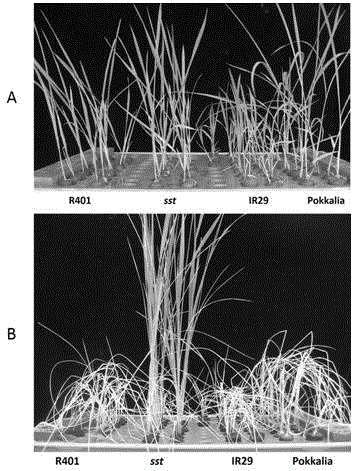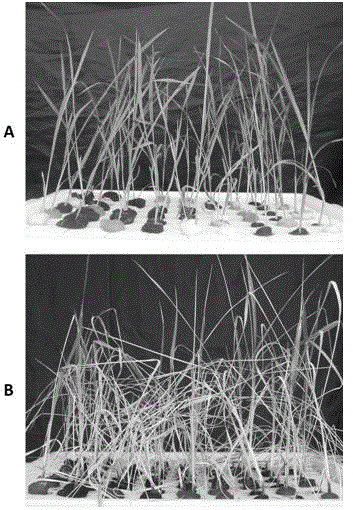Rice SBP-box transcription factor genes and application thereof
A technology of transcription factor and sbp-box, applied in the field of plant bioengineering and plant improvement genetic engineering
- Summary
- Abstract
- Description
- Claims
- Application Information
AI Technical Summary
Problems solved by technology
Method used
Image
Examples
Embodiment 1
[0099] Example 1: SST rice transgenic experiment
[0100] 1. High salt tolerance sst Mutant acquisition and traits
[0101] A rice mutant library containing about 1000 lines was constructed by treating rice seeds with gamma rays. Large-scale screening of the rice mutant library under the salt stress of 150 mM sodium chloride concentration, after repeated verification of the candidate mutants under the salt stress of 150 mM sodium chloride concentration, observation of salt-tolerant phenotypes, and obtaining a performance height salt-tolerant mutant sst .
[0102] with molecular markers SST The gene was initially located on the sixth chromosome of rice. use sst Mutants crossed with salt-sensitive varieties to construct large-scale F 2 Group, using molecular markers to screen the exchanged individuals from the population, combined with the genotype and phenotype of the exchanged individuals, carried out map-based cloning, and successfully cloned SS...
Embodiment 2
[0113] Embodiment 2: Cultivation and salt stress test of transgenic plants
[0114] The seeds of the transgenic rice obtained in Example 1 were taken, and after dormancy was broken in an oven at 45°C for one week, they were sown in petri dishes, soaked in tap water at room temperature for 2 days, and accelerated germination at 37°C for 1 day. After germination, move them into a light incubator, cultivate at 28°C, and light for 11 hours a day. After 1 day, the temperature was gradually lowered to 26°C for another day. After the seedlings are basically out, the tap water is replaced with rice culture medium for cultivation.
[0115] Test results such as figure 1 and figure 2 shown. Such as figure 1 As shown, the rice mutant sst Compared with the wild type (R401), the salt tolerance was significantly improved.
[0116] Depend on figure 2 Visible: the wild-type (R401) SST Genome fragments are transferred by transgene sst Among the mutants, the transge...
Embodiment 3
[0118] Example 3. In different plants SST presence of homologous genes
[0119] A database search (http: / / www.ncbi.nlm.nih.gov / ) found that in Oryza short-anthers ( Oryza brachyantha ), millet ( Setaria italica ), sorghum ( Sorghum bicolor ),wheat( Triticum aestivum ),corn( Zea mays ),barley( Hordeum vulgare ), Urartu Wheat ( Triticum urartu ), Brachypodium distachydium ( Brachypodium distachyon ), Festival wheat ( Aegilops tauschii ) and other genomes have homologous genes. The similarity of proteins ranged from 81.2% to 56.5%.
[0120] These homologous genes all have a conserved SBP domain with high similarity. The sequence is RCQAEGCKADLSGAKHYHRRHKVCEYHAKASVVAASGKQQRFCQQCSRFHVLTEFDEAKRSCRKRLAEHN (positions 180-249 of SEQ ID NO.2). The SBP-box transcription factor protein is combined by the SBP domain and the cis-acting element, so these homologous genes have a corresponding relationship with the cis-acting element, which indicates that othe...
PUM
 Login to View More
Login to View More Abstract
Description
Claims
Application Information
 Login to View More
Login to View More - R&D
- Intellectual Property
- Life Sciences
- Materials
- Tech Scout
- Unparalleled Data Quality
- Higher Quality Content
- 60% Fewer Hallucinations
Browse by: Latest US Patents, China's latest patents, Technical Efficacy Thesaurus, Application Domain, Technology Topic, Popular Technical Reports.
© 2025 PatSnap. All rights reserved.Legal|Privacy policy|Modern Slavery Act Transparency Statement|Sitemap|About US| Contact US: help@patsnap.com



